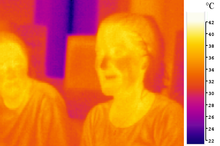

Infrared (IR; sometimes called infrared light) is electromagnetic radiation (EMR) with wavelengths longer than that of visible light but shorter than microwaves. The infrared spectral band begins with waves that are just longer than those of red light (the longest waves in the visible spectrum), so IR is invisible to the human eye. IR is generally understood to include wavelengths from around 750 nm (400 THz) to 1 mm (300 GHz).[1][2] IR is commonly divided between longer-wavelength thermal IR, emitted from terrestrial sources, and shorter-wavelength IR or near-IR, part of the solar spectrum.[3] Longer IR wavelengths (30–100 μm) are sometimes included as part of the terahertz radiation band.[4] Almost all black-body radiation from objects near room temperature is in the IR band. As a form of electromagnetic radiation, IR carries energy and momentum, exerts radiation pressure, and has properties corresponding to both those of a wave and of a particle, the photon.[5]
It was long known that fires emit invisible heat; in 1681 the pioneering experimenter Edme Mariotte showed that glass, though transparent to sunlight, obstructed radiant heat.[6][7] In 1800 the astronomer Sir William Herschel discovered that infrared radiation is a type of invisible radiation in the spectrum lower in energy than red light, by means of its effect on a thermometer.[8] Slightly more than half of the energy from the Sun was eventually found, through Herschel's studies, to arrive on Earth in the form of infrared. The balance between absorbed and emitted infrared radiation has an important effect on Earth's climate.
Infrared radiation is emitted or absorbed by molecules when changing rotational-vibrational movements. It excites vibrational modes in a molecule through a change in the dipole moment, making it a useful frequency range for study of these energy states for molecules of the proper symmetry. Infrared spectroscopy examines absorption and transmission of photons in the infrared range.[9]
Infrared radiation is used in industrial, scientific, military, commercial, and medical applications. Night-vision devices using active near-infrared illumination allow people or animals to be observed without the observer being detected. Infrared astronomy uses sensor-equipped telescopes to penetrate dusty regions of space such as molecular clouds, to detect objects such as planets, and to view highly red-shifted objects from the early days of the universe.[10] Infrared thermal-imaging cameras are used to detect heat loss in insulated systems, to observe changing blood flow in the skin, to assist firefighting, and to detect the overheating of electrical components.[11] Military and civilian applications include target acquisition, surveillance, night vision, homing, and tracking. Humans at normal body temperature radiate chiefly at wavelengths around 10 μm. Non-military uses include thermal efficiency analysis, environmental monitoring, industrial facility inspections, detection of grow-ops, remote temperature sensing, short-range wireless communication, spectroscopy, and weather forecasting.
- ^ Vatansever, Fatma; Hamblin, Michael R. (2012-01-01). "Far infrared radiation (FIR): Its biological effects and medical applications". Photonics & Lasers in Medicine. 1 (4): 255–266. doi:10.1515/plm-2012-0034. ISSN 2193-0643. PMC 3699878. PMID 23833705.
- ^ "Definition of INFRARED". www.merriam-webster.com. 2024-09-18. Archived from the original on 2024-09-22. Retrieved 2024-09-20.
- ^ "IPCC AR4 SYR Appendix Glossary" (PDF). Archived from the original (PDF) on 2018-11-17. Retrieved 2008-12-14.
- ^ Rogalski, Antoni (2019). Infrared and terahertz detectors (3rd ed.). Boca Raton, FL: CRC Press. p. 929. ISBN 978-1-315-27133-0.
- ^ "Infrared radiation | Definition, Wavelengths, & Facts | Britannica". www.britannica.com. 2024-09-18. Retrieved 2024-09-20.
- ^ Calel, Raphael (19 February 2014). "The Founding Fathers v. The Climate Change Skeptics". The Public Domain Review. Archived from the original on 11 October 2019. Retrieved 16 September 2019.
- ^ Fleming, James R. (17 March 2008). "Climate Change and Anthropogenic Greenhouse Warming: A Selection of Key Articles, 1824–1995, with Interpretive Essays". National Science Digital Library Project Archive PALE:ClassicArticles. Archived from the original on 29 September 2019. Retrieved 1 February 2022. Article 1: General remarks on the temperature of the earth and outer space Archived 2023-06-08 at the Wayback Machine.
- ^ Michael Rowan-Robinson (2013). Night Vision: Exploring the Infrared Universe. Cambridge University Press. p. 23. ISBN 1107024765.
- ^ Reusch, William (1999). "Infrared Spectroscopy". Michigan State University. Archived from the original on 2007-10-27. Retrieved 2006-10-27.
- ^ "IR Astronomy: Overview". NASA Infrared Astronomy and Processing Center. Archived from the original on 2006-12-08. Retrieved 2006-10-30.
- ^ Chilton, Alexander (2013-10-07). "The Working Principle and Key Applications of Infrared Sensors". AZoSensors. Archived from the original on 2020-07-11. Retrieved 2020-07-11.